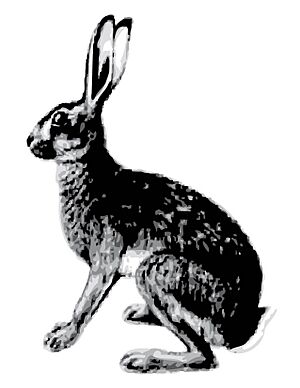Abyssinian hare facts for kids
Quick facts for kids Abyssinian hare |
|
|---|---|
 |
|
| Conservation status | |
| Scientific classification | |
| Genus: |
Lepus
|
| Species: |
habessinicus
|
 |
|
| Abyssinian Hare range | |
The Abyssinian hare (Lepus habessinicus) is a type of mammal. It belongs to the Leporidae family, which includes all hares and rabbits. You can mostly find this hare in the countries of the Horn of Africa. This area is in eastern Africa. Sometimes, it might also be seen in eastern Sudan or northern Kenya.
Contents
What's in a Name? (Taxonomy)
How Scientists Classify Animals
Scientists group living things based on how they are related. This is called taxonomy. It helps us understand the animal kingdom better.
Abyssinian Hare's Family Tree
Some scientists thought the Abyssinian hare might be the same species as the Cape hare. However, most scientists now agree they are different. They are considered separate species because they live in the same areas without mixing.
Meet the Abyssinian Hare
What Does It Look Like?
The Abyssinian hare looks a lot like other hares. It has long legs and big ears. Its body, from head to tail, is about 40 to 55 centimeters (16 to 22 inches) long.
Its Fur and Colors
This hare has soft, thick fur. Its upper body is a silvery-grey color. You might see some black fur on its shoulders, back, and rump. The hairs on its back are about 2 centimeters (0.8 inches) long. Each hair has a greyish-white base, then a black band, and a white or light brown tip. Sometimes, the tip is black too.
Belly and Ears
The hare's sides are lighter in color. Its belly is white, and the fur there is not as thick. A thin cinnamon-colored stripe separates its sides from its white belly. Its chin is whitish. Some hares even have white rings around their eyes.
Its ears are very large. They are silvery-brown on the outside and whitish-buff on the inside. The tips of the ears have a black edge. The lower parts of the ear edges have a white fringe. Its tail is about 8.5 centimeters (3.3 inches) long. It is black on top and white underneath.
Where Do They Live? (Habitat)
Home in the Horn of Africa
The Abyssinian hare lives only in the Horn of Africa. This includes countries like Djibouti, Eritrea, Ethiopia, Somalia, and Sudan. This is called being endemic to a region.
Preferred Landscapes
These hares like to live in different kinds of open areas. You can find them in savannahs (grassy plains with scattered trees) and grasslands. They also live in steppe areas, which are dry, treeless plains. Even in deserts or semi-dry places, they can survive. They just need some small bushes or plants for cover.
Altitude and Location
They can live at high altitudes, up to about 2,000 meters (6,560 feet) above sea level. In Ethiopia, they can even be found higher than that!
See Also


